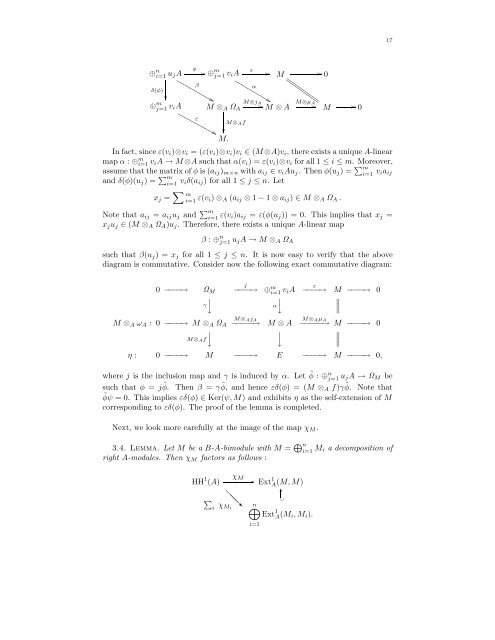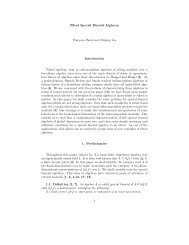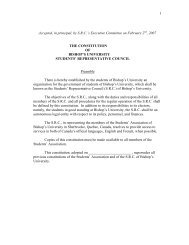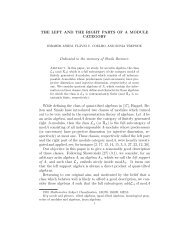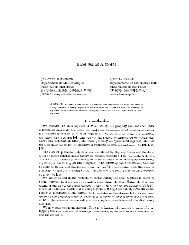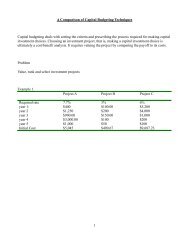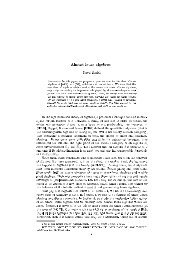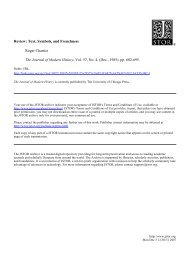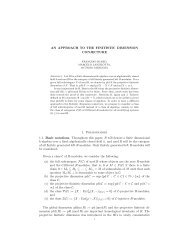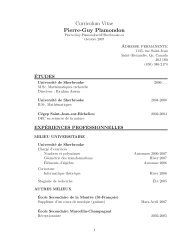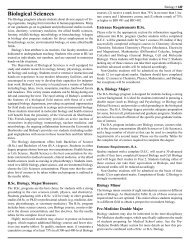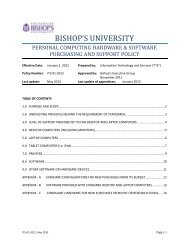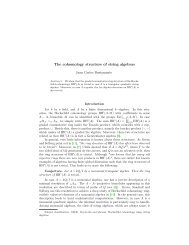Hochschild Cohomology and Representation-finite Algebras Ragnar ...
Hochschild Cohomology and Representation-finite Algebras Ragnar ...
Hochschild Cohomology and Representation-finite Algebras Ragnar ...
Create successful ePaper yourself
Turn your PDF publications into a flip-book with our unique Google optimized e-Paper software.
17<br />
⊕ n i=1 u jA φ ⊕ m j=1 v i A ε M <br />
0<br />
<br />
β<br />
α <br />
δ(φ)<br />
<br />
<br />
<br />
⊕ m j=1 v M⊗j A<br />
iA M ⊗ A Ω A<br />
M ⊗ A M⊗µA M 0<br />
ε<br />
M⊗ Af<br />
<br />
M.<br />
In fact, since ε(v i )⊗v i =(ε(v i )⊗v i )v i ∈ (M ⊗A)v i , there exists a unique A-linear<br />
map α : ⊕ m i=1 v iA → M ⊗A such that α(v i )=ε(v i )⊗v i for all 1 ≤ i ≤ m. Moreover,<br />
assume that the matrix of φ is (a ij ) m×n with a ij ∈ v i Au j .Thenφ(u j )= ∑ m<br />
i=1 v ia ij<br />
<strong>and</strong> δ(φ)(u j )= ∑ m<br />
i=1 v iδ(a ij ) for all 1 ≤ j ≤ n. Let<br />
x j = ∑ m<br />
i=1 ε(v i) ⊗ A (a ij ⊗ 1 − 1 ⊗ a ij ) ∈ M ⊗ A Ω A .<br />
Note that a ij = a ij u j <strong>and</strong> ∑ m<br />
i=1 ε(v i)a ij = ε(φ(u j )) = 0. This implies that x j =<br />
x j u j ∈ (M ⊗ A Ω A )u j . Therefore, there exists a unique A-linear map<br />
β : ⊕ n j=1 u jA → M ⊗ A Ω A<br />
such that β(u j )=x j for all 1 ≤ j ≤ n. It is now easy to verify that the above<br />
diagram is commutative. Consider now the following exact commutative diagram:<br />
j<br />
0 −−−−→ Ω M −−−−→<br />
⏐<br />
γ↓<br />
⊕ m i=1 v iA<br />
⏐<br />
α↓<br />
ε<br />
−−−−→ M −−−−→ 0<br />
∥<br />
M ⊗ A ω A : 0 −−−−→ M ⊗ A Ω A<br />
⏐<br />
M⊗ Af↓<br />
M⊗ Aj A<br />
M⊗ Aµ A<br />
−−−−−→ M ⊗ A −−−−−→ M −−−−→ 0<br />
⏐<br />
↓<br />
∥<br />
η : 0 −−−−→ M −−−−→ E −−−−→ M −−−−→ 0,<br />
where j is the inclusion map <strong>and</strong> γ is induced by α. Let ˜φ : ⊕ n j=1 u jA → Ω M be<br />
such that φ = j ˜φ. Then β = γ ˜φ, <strong>and</strong> hence εδ(φ) =(M ⊗ A f)γ ˜φ. Note that<br />
˜φψ = 0. This implies εδ(φ) ∈ Ker(ψ, M) <strong>and</strong> exhibits η as the self-extension of M<br />
corresponding to εδ(φ). The proof of the lemma is completed.<br />
Next, we look more carefully at the image of the map χ M .<br />
3.4. Lemma. Let M be a B-A-bimodule with M = ⊕ n<br />
i=1 M i a decomposition of<br />
right A-modules. Then χ M factors as follows :<br />
HH 1 χ M<br />
(A) ✲ Ext<br />
1<br />
A (M,M)<br />
❅ ✻<br />
∑ ❅❅<br />
i χ ∪<br />
M i<br />
❘ n⊕<br />
Ext 1 A(M i ,M i ).<br />
i=1


